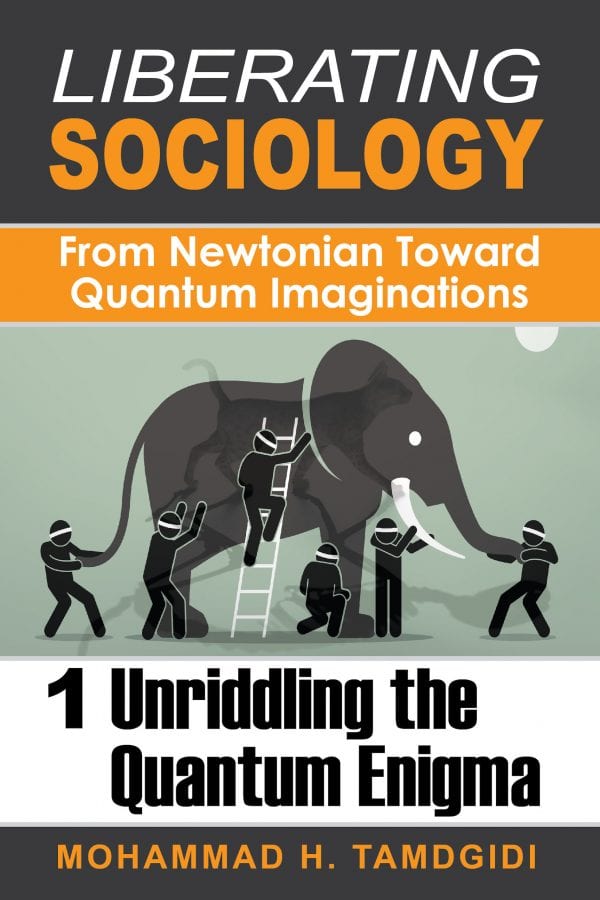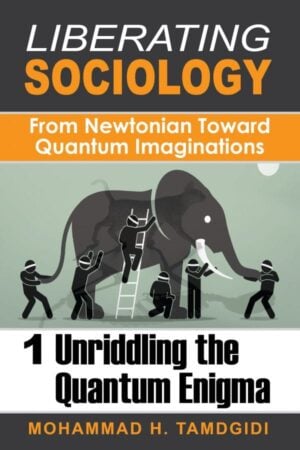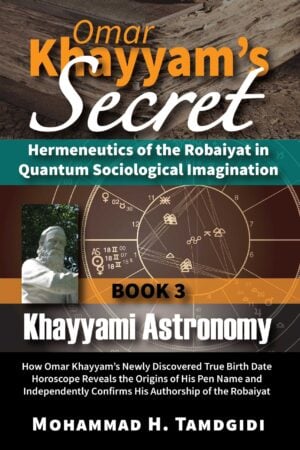Liberating Sociology: From Newtonian Toward Quantum Imaginations: Volume 1: Unriddling the Quantum Enigma
$69.00 – $119.00
In this new major study in the sociology of scientific knowledge, the first volume in the series Liberating Sociology, the transdisciplinary social theorist Mohammad H. Tamdgidi reports having unriddled the puzzle of a decades-old cat gone elephant in a room of science, the quantum enigma.
Publication Date: January 20, 2020
Note: The ePub ebook edition of this title (ISBN: 9781640980129) can be purchased from major online ebook stores worldwide.

All the sections of this publication can be read online by logged-in members of the OKCIR Library with a valid access. In that case click on any section in the table of contents below, and then click on the large PDF icon at the bottom of that page to access the publication section. Alternatively, you can purchase this publication as offered below.
Description
Liberating Sociology : From Newtonian Toward Quantum Imaginations
Volume 1: Unriddling the Quantum Enigma
Author: Mohammad H. Tamdgidi
Publication Date: January 20, 2020
Human Architecture: Journal of the Sociology of Self-Knowledge (ISSN: 1540-5699)
Volume XIII, 2020, Monograph Series: Tayyebeh Series in East-West Research and Translation
Description
In this major new study in the sociology of scientific knowledge, the transdisciplinary social theorist Mohammad H. Tamdgidi reports having unriddled the puzzle of a decades-old cat gone elephant in a room of science, the quantum enigma.
This book opens the lid of the Schrödinger’s Cat box of the ‘quantum enigma’ after decades and finds something both odd and familiar: Not only the cat is both alive and dead, it has morphed into an elephant in the room in whose interpretation Einstein, Bohr, Bohm, and others were each both right and wrong because the enigma has acquired both localized and spread-out features whose unriddling requires both physics and sociology amid both transdisciplinary and transcultural contexts. The book offers, in a transdisciplinary and transcultural sociology of self-knowledge framework, a relativistic interpretation to advance a liberating quantum sociology.
Deeper methodological grounding to further advance the sociological imagination requires investigating whether and how relativistic and quantum scientific revolutions can induce a liberating reinvention of sociology in favor of creative research and a just global society. This, however, necessarily leads us to confront an elephant in the room, the ‘quantum enigma.’
In Unriddling the Quantum Enigma, the first volume of the series commonly titled Liberating Sociology: From Newtonian toward Quantum Imaginations, sociologist Mohammad H. Tamdgidi argues that unriddling the ‘quantum enigma’ depends on whether and how we succeed in dehabituating ourselves in favor of unified relativistic and quantum visions from the historically and ideologically inherited, classical Newtonian modes of imagining reality that have subconsciously persisted in the ways we have gone about posing and interpreting (or not) the enigma itself for more than a century. Once this veil is lifted and the enigma unriddled, he argues, it becomes possible to reinterpret the relativistic and quantum ways of imagining reality (including social reality) in terms of a unified, nonreductive, creative dialectic of part and whole that fosters quantum sociological imaginations, methods, theories, and practices favoring liberating and just social outcomes.
The essays in this volume develop a set of relativistic interpretive solutions to the quantum enigma. Following a survey of relevant studies, and an introduction to the transdisciplinary and transcultural sociology of self-knowledge framing the study, overviews of Newtonianism, relativity and quantum scientific revolutions, the quantum enigma, and its main interpretations to date are offered. They are followed by a study of the notion of the “wave-particle duality of light” and the various experiments associated with the quantum enigma in order to arrive at a relativistic interpretation of the enigma, one that is shown to be capable of critically cohering other offered interpretations. The book concludes with a heuristic presentation of the ontology, epistemology, and methodology of what Tamdgidi calls the creative dialectics of reality. The volume essays involve critical, comparative/integrative reflections on the relevant works of founding and contemporary scientists and scholars in the field.
This study is the first in the monograph series “Tayyebeh Series in East-West Research and Translation” of Human Architecture: Journal of the Sociology of Self-Knowledge (XIII, 2020), published by OKCIR: Omar Khayyam Center for Integrative Research in Utopia, Mysticism, and Science (Utopystics). OKCIR is dedicated to exploring, in a simultaneously world-historical and self-reflective framework, the human search for a just global society. It aims to develop new conceptual (methodological, theoretical, historical), practical, pedagogical, inspirational and disseminative structures of knowledge whereby the individual can radically understand and determine how world-history and her/his selves constitute one another.
Reviews of Liberating Sociology: From Newtonian Toward Quantum Imaginations: Volume 1: Unriddling the Quantum Enigma
“Mohammad H. Tamdgidi’s Liberating Sociology: From Newtonian Toward Quantum Imaginations, Volume 1, Unriddling the Quantum Enigma hits the proverbial nail on the head of an ongoing problem not only in sociology but also much social science—namely, many practitioners’ allegiance, consciously or otherwise, to persisting conceptions of ‘science’ that get in the way of scientific and other forms of theoretical advancement. Newtonianism has achieved the status of an idol and its methodology a fetish, the consequence of which is an ongoing failure to think through important problems of uncertainty, indeterminacy, multivariation, multidisciplinarity, and false dilemmas of individual agency versus structure, among many others. Tamdgidi has done great service to social thought by bringing to the fore this problem of disciplinary decadence and offering, in effect, a call for its teleological suspension—thinking beyond disciplinarity—through drawing upon and communicating with the resources of quantum theory not as a fetish but instead as an opening for other possibilities of social, including human, understanding. The implications are far-reaching as they offer, as the main title attests, liberating sociology from persistent epistemic shackles and thus many disciplines and fields connected to things ‘social.’ This is exciting work. A triumph! The reader is left with enthusiasm for the second volume and theorists of many kinds with proverbial work to be done.” — Professor Lewis R. Gordon, Honorary President of the Global Center for Advanced Studies and author of Disciplinary Decadence: Living Thought in Trying Times (Routledge/Paradigm, 2006), and Freedom, Justice, and Decolonization (Routledge, forthcoming 2020)
“Social sciences are still using metatheoretical models of science based on 19th century newtonian concepts of “time and space”. Mohammad H. Tamdgidi has produced a ‘tour de force’ in social theory leaving behind the old newtonian worldview that still informs the social sciences towards a 21st century non-dualistic, non-reductionist, transcultural, transdisciplinary, post-Einsteinian quantum concept of TimeSpace. Tamdgidi goes beyond previous efforts done by titans of social theory such as Immanuel Wallerstein and Kyriakos Kontopoulos. This book is a quantum leap in the social sciences at large. Tamdgidi decolonizes the social sciences away from its Eurocentric colonial foundations bringing it closer not only to contemporary natural sciences but also to its convergence with the old Eastern philosophical and mystical worldviews. This book is a masterpiece in social theory for a 21st century decolonial social science. A must read!” — Professor Ramon Grosfoguel, University of California at Berkeley
“Tamdgidi’s Liberating Sociology succeeds in adding physical structures to the breadth of the world-changing vision of C. Wright Mills, the man who mentored me at Columbia. Relativity theory and quantum mechanics can help us to understand the human universe no less than the physical universe. Just as my Creating Life Before Death challenges bureaucracy’s conformist orientation, so does Liberating Sociology“liberate the infinite possibilities inherent in us.” Given our isolation in the Coronavirus era, we have time to follow Tamdgidi in his journey into the depth of inner space, where few men have gone before. It is there that we can gain emotional strength, just as Churchill, Roosevelt and Mandela empowered themselves. That personal development was needed to address not only their own personal problems, but also the mammoth problems of their societies. We must learn to do the same.” — Bernard Phillips, Emeritus Sociology Professor, Boston University
About the Author
Mohammad H. Tamdgidi (pronounced ‘tamjidi’), Ph.D., has previously authored Advancing Utopistics: The Three Component Parts and Errors of Marxism (Routledge/Paradigm) and Gurdjieff and Hypnosis: A Hermeneutic Study (Palgrave Macmillan). Formerly an associate professor of sociology at UMass Boston specializing in social theory, he is the founding director and editor of OKCIR: Omar Khayyam Center for Integrative Research in Utopia, Mysticism, and Science (Utopystics) (est. 2002, www.okcir.com) and its scholarly journal, Human Architecture: Journal of the Sociology of Self-Knowledge (ISSN: 1540-5699). Tamdgidi holds a Ph.D. and M.A. in sociology in conjunction with a graduate certificate in Middle Eastern studies from Binghamton University (SUNY). He received his B.A. in architecture from U.C. Berkeley, following enrollment as an undergraduate student of civil engineering in the Technical College of the University of Tehran, Iran.

Liberating Sociology: From Newtonian Toward Quantum Imaginations: Volume 1: Unriddling the Quantum Enigma
Published by: Okcir Press (an imprint of Ahead Publishing House) • Belmont, Massachusetts • First Edition: January 20, 2020
1000 pages • 6×9 inches • Includes references, illustrations, bibliography, and index
Library of Congress Control Number (LCCN): 2019914517
ISBN-13: 9781640980105 • ISBN−10: 1640980105 (hard cover: alk. paper)
ISBN-13: 9781640980112 • ISBN−10: 1640980113 (soft cover: alk. paper)
ISBN-13: 9781640980129 • ISBN−10: 1640980121 (ePub ebook)
ISBN-13: 9781640980136 • ISBN−10: 164098013X (PDF ebook)
The various editions of Liberating Sociology (vol. 1) are also available for ordering from all major online bookstores worldwide (such as Amazon, Barnes&Noble, and others).
Table of Contents of Liberating Sociology: From Newtonian Toward Quantum Imaginations: Volume 1: Unriddling the Quantum Enigma
List of Figures—xvii
Acknowledgments—xix
Common Preface to the Series—1
Introduction: An Elephant in the Room of Physics and the Sociological Imagination—21
I. Opening: C. Wright Mills, the Sociological Imagination, and the “Improperly Felt to Be Wonderfully Mysterious”—22
II. The Elephant in the Room that is the ‘Quantum Enigma’—29
III. The Approach and Organization of this Study—34
IV. Suggestions about Reading this Book—40
CHAPTER 1 — Quantum Society Roundtable: Prior Studies Relevant to this Work—43
I. Introduction: The ‘Implicate’ David Bohm—44
II. Danah Zohar’s ‘Quantum Self and Society’—47
III. Alexander Wendt’s ‘Walking Wave Functions’—56
IV. Bruce Rosenblum and Fred Kuttner’s ‘Quantum Enigma’—67
V. The Contributions of Amit Goswami, Jim Al-Khalili, and Neil Turok—76
VI. Basarab Nicolescu’s ‘Manifesto of Transdisciplinarity’—80
I. Introduction—105
II. The Sociology of Knowledge and Karl Mannheim—106
III. Ideology and Utopia in “Ideology and Utopia”—110
IV. Theoretical Roots—116
V. Methodological Grounds—124
VI. Inventing the Sociology of Self-Knowledge—126
VII. Conclusion—130
Epilogue—132
(1) Dualism: Can an Object be A and non-A at the Same Time and Place?—161
(2) Atomism: What is the Micro Unit of Analysis of the Object?—161
(3) Separability: What is the Macro Unit of Analysis of the Object?—163
(4) Objectivity: Does the Object Being Observed Have an Independent Reality?—163
(5) Determinism: Can Causes and Consequences of Moving Objects be Predictable?—165
(6) Continuity: Does Change Happen Through Chains of Local Causations—168
(7) Disciplinarity: The Fragmentation of Knowledge of Reality—169
(8) Scientism: The Presumed Superiority of Western Way of Thinking—169
CHAPTER 4 — Whose Enigma?: From Classical Newtonianism to Relativity and the Quantum Revolution—175
(1) From Dualism to “Duality” (of Two Kinds: Complementarity and Simultaneity)—202
(2) From Atomism to Superpositionality—204
(3) From Separability to Inseparability—206
(4) From (Subjectless) Objectivity to (Subject-Included) Relativity—209
(5) From Determinism to Probability—211
(6) From Continuity to “Discontinuity” (or “Transcontinuity”?)—214
(7) From Disciplinarity to Transdisciplinarity—216
(8) From Scientism to Transculturalism—217
CHAPTER 5 — Approaching the Elephant in the Room: The Many Interpretations of the Quantum Enigma—225
I. Introduction—226
II. What Exactly Is the So-called ‘Quantum Enigma’?—229
III. ‘Classifying’ the Many Interpretations of the Quantum Enigma—238
IV. The Standard and Extreme Copenhagen Interpretations—242
V. The Incomplete Knowledge Interpretation—245
VI. The Pilot-Wave Interpretation—248
VII. The Many Worlds and the Many Minds Interpretations—252
VIII. The Decoherence Interpretation—255
IX. The Consciousness Cause Interpretations—258
X. Other Interpretative Contributions: Ithaca, Transactional, and Logical—264
I. Introduction—270
II. Dualism, Duality, Complementarity, and Simultaneity—280
III. An Overview of the Thought Experiments Associated with Einstein’s Special and General Theorizations of Relativity—289
IV. The Imaginal Oversight in the Thought Experiments Associated with Einstein’s Theorizations of Relativity that Engendered the Enigma of the “Wave-Particle Duality of Light”—318
V. Conclusion: The Localized/Spread-out Simultaneity of Photon As Always a Wave—363
I. Introduction—370
II. The Enigma of the Double-Slit Experiment: Can an Indivisible Unit of Energy Split?—377
III. The Enigma of Quantum Entanglement: Are Not These Now Two Ends of the Same Stick?—400
IV. The Enigma of the Delayed-Choice Experiment: Does a Beam-Splitter Split Each Photon?—418
V. The Enigma of Two “Levels” of Reality: Recovering from a Misstep in the “Reality Escalator” Thought Experiment—431
VI. The Enigma of the Schrödinger’s Cat: How a Radioactively Endangered Quantum Cat in a Box Morphed into a Radioactively Endangering Newtonian Elephant in the Room—456
I. Introduction—473
II. Cohering Across and With Einstein’s Incomplete Knowledge and Bohr’s Copenhagen Interpretations—476
III. Cohering with the Pilot-Wave Interpretation—510
IV. Cohering Across and With the Many Worlds and the Many Minds Interpretations—518
V. Cohering with Decoherence Interpretations—524
VI. Cohering with Various Consciousness Cause Interpretations—529
VII. Cohering with the Ithaca, Transactional, and Quantum Logic Interpretations—538
VIII. Describing the Elephant as a Whole: Cohering the Interpretive Chunks into the Relativistic Interpretation—541
CHAPTER 9 — The Creative Dialectics of Reality: Ontology, Epistemology, and Methodology—555
I. Introduction—556
II. Interpreting Dialectics Dialectically—561
III. Splitting the Creative Research Labor Process to Study Its Contradictory Parts—565
IV. Dialectical Methodology: Dialectics of Dialectical Ontology and Epistemology—580
V. Dialectics of the Creative Research Labor Process as a Whole—630
VI. Dialectics of the Development of “Dialectics”: An Historical Outline—635
VII. The Creative Dialectical Method—645
I. Chapters Summary—651
II. Narrative Summary—66
III. Pointed Summary—679
IV. Rejoining the Quantum Society Roundtable—707
V. Toward Quantum Sociological Imaginations—715
References—723
The Social Quantum Enigma: A Chronological Bibliography—739
Index—933






